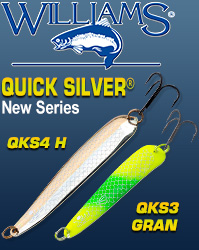Walleye stocking records shattered as first year of initiative ends
HAYWARD – Stocking records for large fingerling walleye were shattered Tuesday as the last load of walleye produced in 2013 under theWisconsin Walleye Initiative
was delivered to Smith Lake in Sawyer County. Watch video of that final stocking.
The lake was the 100th water body to receive the 6- to 8-inch walleye, often called large fingerlings or extended growth walleye. In all, 440,481 6- to 8-inch large walleye fingerlings were stocked in Wisconsin in September, October and November. Watch video of that final stocking and learn more about the Wisconsin Walleye Initiative in this new video.
That’s more than four times as many larger walleye as is typically produced and stocked in Wisconsin, and it was made possible through a two-year funding initiative aimed at improving walleye fishing statewide through stocking more of the larger walleye that survive better, says DNR Secretary Cathy Stepp.
“This is fantastic news for walleye anglers and the businesses that depend on them,” Stepp says.
“The governor and legislature made an important investment in making walleye fishing even better in Wisconsin and our staff stepped up to the challenge. They showed what they can do when the funding is there -- produced a record-breaking number of larger fingerling walleye to stock Wisconsin waters.”
Stepp says DNR also was pleased to be able to buy fish raised from private fish farms for stocking this year, and looks forward to coming years, when the funding initiative provides $500,000 in each of the next two years to buy fish from private, municipal and tribal hatcheries.
DNR hatcheries raised the lion’s share of the fish, 416,506 large fingerlings, 3 percent over the target number for the year. Private fish farms provided another 23,975 of the larger fingerlings.
Mike Staggs, Wisconsin’s fisheries director, also praised the staff, noting that walleye were already at the hatcheries when the budget passed in June and DNR was assured it would get more money to help keep more of the fish longer at the hatcheries. Staff worked quickly to find production space and put in place the logistics and supplies needed to grow such a large number of larger walleye.
Typically, DNR stocks most walleye when they are 1.5 to 2 inches long because raising them to a larger size becomes much more expensive and takes up much more space. With the initiative, DNR was able to keep four times as many of the larger fingerlings in the hatcheries compared to prior years. The extra funding -- $870,700 for this year and $1.3 million for next year’s operating costs -- allowed DNR to buy minnows for the walleye to eat and allowed the agency to put more ponds into raising larger fingerlings.
“It was a real credit to our DNR hatchery staff and the other fisheries staff involved to be able, on extremely short notice, to quadruple fingerling production,” Staggs says. “Anglers are going to enjoy the benefits of this in a few years.”
The fish were stocked in lakes based on the requests biologists submitted earlier for fish for stocking. The increased production allowed DNR to go much deeper down the list to fill the biologists’ requests.
While Wisconsin’s best walleye waters are naturally self-sustaining and provide over 80 percent of the fish reported caught by anglers, there are many waters where DNR hopes that stocking more, larger walleye can help improve the walleye populations and provide walleye fishing opportunities that otherwise wouldn’t exist, Staggs says.
“There are a lot of lakes that can really benefit from the Wisconsin Walleye Initiative, and this first year of production is our first installment in making that happen.”
Still time to take walleye survey to help guide stocking in 2014 and beyond
Walleye anglers and others interested in walleye management can still take an online public survey through the end of November to help shape the state’s future stocking strategy for walleye. The short questionnaire aims to help DNR update its walleye stocking strategy and walleye management plan in general.
The survey is found on DNR’s Wisconsin Walleye Initiative Web page, which contains a variety of materials relating to the walleye initiative. It can be reached from DNR’s home page, dnr.wi.gov, and searching for “walleye.”









